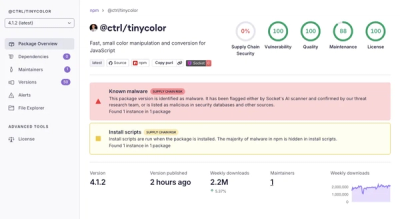
Research
/Security News
Popular Tinycolor npm Package Compromised in Supply Chain Attack Affecting 40+ Packages
Malicious update to @ctrl/tinycolor on npm is part of a supply-chain attack hitting 40+ packages across maintainers
@huddly/sdk
Advanced tools
Huddly's Software Development Kit (SDK) used to interact with the camera by third-party applications

Huddly SDK works with the following NodeJS releases: (Needs to support NAPI v3 )
We recommend using nvm as your node version manager https://github.com/creationix/nvm.
After you've setup nvm run
nvm install 16
nvm use 16
With the node environment setup and ready, go ahead and install our sdk as part of your project dependencies:
npm install @huddly/sdk@latest
You also need to install some other Huddly npm dependencies from which the SDK relies on for device discovery and communication. Depending on which product (camera) you will be working with, the corresponding device api packages must be accompanied with the SDK:
npm install @huddly/device-api-usb # For interacting with our USB cameras
npm install @huddly/device-api-ip # For interacting with our Ethernet/IP comeras
It is also possible to install both of them and configure the SDK which one to use for discovery and/or communication.
The example below illustrates how to setup the SDK instance to communicate with a Huddly camera connected to the host machine. Start by creating the sdk and the transport apis:
const HuddlyDeviceAPIUSB = require('@huddly/device-api-usb').default;
const HuddlyDeviceApiIP = require('@huddly/device-api-ip').default;
const HuddlySdk = require('@huddly/sdk').default;
// Create instances of device-apis you want to use. These APIs also take configuration parameters which can be consulted by the IDeviceApiOpts interface.
const usbApi = new HuddlyDeviceAPIUSB();
const ipApi = new HuddlyDeviceApiIP();
/*
Creating the SDK instance requires you to provide the following:
- DeviceAPI instance (or a lis of different DeviceApi instances) responsible for doing discovery (1st constructor argumet)
- An optional list of DeviceApi instances that can be used for communication (if ommitted the discovery device api will also be used for communication).
*/
// To setup an sdk instance that works with USB devices only, you'd do:
const sdk = new HuddlySdk(usbApi);
// To setup an sdk instance that works with IP devices only, you'd do:
const sdk = new HuddlySdk(ipApi);
// **BETA Feature** To setup an sdk that work with discovering both usb and ip cameras, you'd do:
const sdk = new HuddlySdk([usbApi, ipApi], [usbApi, ipApi]);
The SDK instance will fire ATTACH events if it finds a camera connected on the host or if a camera is connected at a later stage. The code below listens to attach events from the SDK and initilizes a camera manager instance:
// Create a instance that will represent the `IDeviceManager` interface
let cameraManager;
sdk.on('ATTACH', (newDevice) => {
cameraManager = newDevice;
});
Now since the attach event listener has been set up, we can initilize the SDK and allow it to start the device discovery process:
sdk.init();
That's it on the SDK initialization process. All the actions on the cameraManager instance are done after the attach event. For example, to get the camera information, call getInfo when the camera is attached:
sdk.on('ATTACH', (newDevice) => {
cameraManager = newDevice;
cameraManager.getInfo().then(console.log);
});
To always get the latest release of the SDK and the corresponding transport libraries (@huddly/device-api-*) you can add some extra steps to your build pipeline to do just that. Npm facilitates this for you by simply running an update command as below:
npm update @huddly/sdk
The command above will make sure that your project is using the latest release of @huddly/sdk. Keep in mind that the command above will make changes to your package.json and package-lock.json files to compensate for the new changes (if any).
In case you always want the latest patch updates on the library you can use the tilde ~ prefix in front of the version on the package.json file:
"@huddly/sdk": "~0.6.5"
The above version scheme will use releases from 0.6.5 to <0.7.0. Another alternative is to use caret ^ symbol in front of the version string which tells npm to use all future minor/patch versions without incrementing the major version. For example:
"@huddly/sdk": "^0.6.5"
will use releases from 0.6.5 to <1.0.0. Major updates will have to be updated manually due to the potential of breaking changes involved with the new update.
If you have a question or found a bug please open an issue. Thank you
npm install fails on M1 mac because of missing GRPC dependency.
For more details on the rest of the functionality to the sdk check out developer.huddly.com for the different classes, interfaces, enums and more which some of them having example code as well.
All code samples and usage demos can be found on the official Huddly SDK sample repository.
Check out the sdk code on github (https://github.com/Huddly/sdk)
Version 0.7.0 of the SDK comes with some breaking changes for the Huddly IP/Network cameras. The breaking change lies on the product id (PID) used to identify the L1 cameras. Before version 0.7.0, all L1 cameras reported the following pid 0x3E9 (1001 in decimal), whereas with version 0.7.0 the new reported pid is 0x4d3f64b (81000011 in decimal). This was a necessary change to comply with the actual product ID values that the cameras report when broadcasting their presence on the network. For those of you who are dependent on product ids for filtering/identifying the different Huddly cameras, you can import the following enum class which contains the PID hex values for all the Huddly cameras:
const HuddlyHex = require('@huddly/sdk-interfaces/lib/enums/HuddlyHex').default;
// To import L1 product id, use the following enum value
const l1Pid = HuddlyHex.L1_PID;
// To import IQ product id, use the following enum value:
const iqPid = HuddlyHex.BOXFISH_PID;
// And so on... Open "HuddlyHex" enum implementation to see the rest of the available PIDs
Internally the camera always sees full field of view, the coordinates are relative to full field of view by default. If you want the coordinates to be be absolute to the current framing, you can specify this when you get the detector.
cameraManager.getDetector({ convertDetections: 'FRAMING' });
This makes it easy to draw these bbox directly on top of the main stream.
Another available detector configuration is the shouldAutoFrame option which when set to false, it allows you to configure Genius Framing to send detection data without autoframing.
cameraManager.getDetector({ shouldAutoFrame: false });
By default, the detector is configured to run autoframing and generate detection information.
If you want to get detection data only when the camera is streaming on the host machine, you need to configure the detector class with the DOWS option.
cameraManager.getDetector({ DOWS: true });
This option makes it possible to configure the detector so that you only get detection data when you are streaming on host machine. By default, this option set to false so that you don't have to stream to get detection data.
After v0.4.0, SDK comes with a new feature ragarding the way you get detection data from the camera. On this version (and onward) the default behavior of detector is starting an internal stream (controlled by the camera only) to give you detection information. As a result the LED light is turned ON. Proper tearing down of the detector instance will stop the internal stream on the camera and with it the LED light.
Make sure that no other application such as the Huddly app or another sdk instance is running and using the camera.
No. To make sure that camera is compatible with the sdk the documented api gets thoroughly tested. We do not guarantee that undocumented functionality will not break/change from sdk version to sdk version, or camera sw to camera sw.
The current implementation of the SDK does not support having two usb cameras connected to the host at the same time. However, having one Huddly usb camera (IQ, Canvas, GO) and one Huddly IP camera (L1) is supported.
FAQs
Huddly's Software Development Kit (SDK) used to interact with the camera by third-party applications
We found that @huddly/sdk demonstrated a not healthy version release cadence and project activity because the last version was released a year ago. It has 1 open source maintainer collaborating on the project.
Did you know?

Socket for GitHub automatically highlights issues in each pull request and monitors the health of all your open source dependencies. Discover the contents of your packages and block harmful activity before you install or update your dependencies.

Research
/Security News
Malicious update to @ctrl/tinycolor on npm is part of a supply-chain attack hitting 40+ packages across maintainers

Security News
pnpm's new minimumReleaseAge setting delays package updates to prevent supply chain attacks, with other tools like Taze and NCU following suit.

Security News
The Rust Security Response WG is warning of phishing emails from rustfoundation.dev targeting crates.io users.